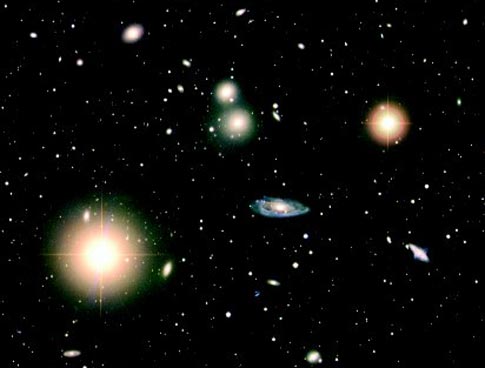An international team of scientists, led by University of Maryland astronomer Stacy McGaugh, has found that individual galactic objects have less ordinary matter, relative to dark matter, than does the universe as a whole.
McGaugh presented these results, recently published in the Astrophysics Journal electronic version, Wednesday from the American Astronomical Society Meeting in Washington, D.C.
Scientists believe all ordinary matter, the protons and neutrons that make up people, planets, stars, and all that we can see, are a mere fraction — some 17 percent — of the total matter in the universe. The protons & neutrons of ordinary matter are referred to as baryons in particle physics and cosmology.
The remaining 83 percent apparently is the mysterious “dark matter,” the existence of which is inferred largely from its gravitational pull on visible matter. Dark matter, explains McGaugh, “is presumed to be some new form of non-baryonic particle — the stuff scientists hope the Large Hadron Collider at CERN will create in high-energy collisions between protons.”
McGaugh and his colleagues posed the question of whether the “universal” ratio of baryonic matter to dark matter holds on the scales of individual structures like galaxies.
“One would expect galaxies and clusters of galaxies to be made of the same stuff as the universe as a whole, so if you make an accounting of the normal matter in each object, and its total mass, you ought to get the same 17 percent fraction,” he says. “However, our work shows that individual objects have less ordinary matter, relative to dark matter, than you would expect from the cosmic mix; sometimes a lot less!”
Just how much less depends systematically on scale, according to the researchers. The smaller an object, the further its ratio of ordinary matter to dark matter is from the cosmic mix. McGaugh says their work indicates that the largest bound structures, rich clusters of galaxies, have 14 percent of ordinary baryonic matter, close to the expected 17 percent.
“As we looked at smaller objects — individual galaxies and satellite galaxies — the normal matter content gets steadily less,” he says. “By the time we reach the smallest dwarf satellite galaxies, the content of normal matter is only about 1 percent of what it should be. [Such galaxies’ baryon content is about 0.2 percent instead of 17 percent.] The variation of the baryon content is very systematic with scale. The smaller the galaxy, the smaller is its ratio of normal matter to dark matter. Put another way, the smallest galaxies are very dark matter dominated.
“This raises an obvious question,” McGaugh says. “Where are all these missing baryons? The short answer is, we don’t know. There are various lines of speculation, most of which are either easily dismissed or are untestable. So, for now, this is a problem without an obvious solution.”










